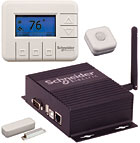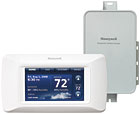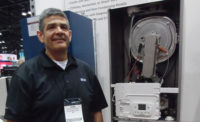
Bryant
Heating and Cooling Systems’ Evolution control
The control is the brains of a Bryant Evolution comfort system, which includes a furnace, fan coil, air conditioner or heat pump, and accessories such as humidifiers and advanced air filtration products. The communicating device allows consumers to continually monitor and manage their homes’ comfort levels in up to eight separate zones by regulating temperature, humidity, and air quality.
The control optimizes overall static pressure measurement and auto configures by accounting for ductwork and filter media type, eliminating guesswork by the installer and enabling the homeowner to receive filter change notifications based on TrueSense™ airflow measurements regardless of filter type. Additionally, the control offers altitude settings to modify airflow for improved comfort.
The control can monitor up to 83 diagnostic points. The system identifies potential issues by providing system alerts and can notify homeowners when it’s time for regular service checkups or filter replacements. Remote connectivity via a system access module mounted inside the home allows homeowners and dealers to receive real-time system status updates.
Features such as weekly and vacation scheduling, remote monitoring, and zone temperature control allow consumers to cut their energy costs while efficiently customizing their indoor conditions.

Schneider
Electric’s Cassia Energy Management System
The system utilizes a customizable software interface that provides real-time energy monitoring and reporting tailored to the needs of the facility. In each room, battery-powered thermostats, lighting controls, and sensors are deployed and communicate via Zigbee® wireless technology. The components of the in-room system utilize wireless technology.
The Cassia EMS also enables guests to control their temperature and lighting settings while in the room. When a guest room is vacated, wireless sensors restore the temperature to the original pre-sets put in place by the facility operator. Additionally, signals can be sent to all light switches to turn off. When the guest re-enters the room, occupancy is detected and the Cassia EMS restores the guest’s preferred lighting and temperature settings.

The
Prestige IAQ system from Honeywell
Prestige IAQ can help contractors connect with customers after initial installation by reminding homeowners when it’s time to replace their furnace filter, humidifier pad, or ultraviolet (UV) lamp. It can also remind them to schedule a spring or fall systems check. Up to 10 reminders can be set from either pre-set options or ones created by the contractor. Automated messages direct homeowners to a screen with their contractor’s full-color company logo, phone number, and website.
Prestige’s patented, interview-based interface walks a homeowner through the set-up process by asking a series of questions such as “What time does the first person wake-up in the morning?” or “What time do you go to sleep at night?” The answers help the thermostat program itself - no owner’s manual needed.

CAN2GO’s
new VAV building automation controller
The VAV controller is a fully programmable device with an onboard pressure sensor capable of meeting VAV application requirements. The Can2Go controller can act either as a stand-alone product or be integrated into a larger BACnet system.
The controllers are unique in that they support two-way communication and control with wired and wireless end devices, says the company. Employed as gateways, the controllers convert EnOcean and wired end devices to BACnet objects, enabling seamless integration into BACnet systems. They can also act as servers, hosting a complete IP web-interface capable of managing all controllers and their end devices. For further flexibility, the controllers can communicate with each other wirelessly, through a wired Ethernet/IP network, or via chain-linked CANbus serial bus.

Venstar’s
ColorTouch thermostat
Every time the user runs the ColorTouch Assistant software, it automatically connects to the ColorTouch website in the background and updates the software and firmware at no cost. The firmware updates the SD memory card to be uploaded to the thermostat, which then updates the thermostat. Users can customize the appearance of their ColorTouch thermostats by using their own photos for the screensavers and background wallpaper. With the ColorTouch Assistant, users can customize their photos and see how the photo will look as background wallpaper once the thermostat information is placed over the photo. Users may install up to 100 photos for the thermostat, all of which can rotate as a slideshow when the thermostat is in screen-saver mode.
The ColorTouch’s intuitive “Time Period” scheduler automatically changes the temperature and mode for up to four periods per day, allowing for comfortable temperatures for sleeping, waking, and daytime, plus an energy-savings mode for when no one is home.

Aircuity’s
OptiNet system
Standard dry bulb temperature-based economizers cannot compensate for the effect of moisture on energy consumption. But OptiNet samples both the temperature and the moisture content of return air and outside air in order to obtain a true gauge of the enthalpy of the air. This differential enthalpy maximizes available free cooling and lets the system determine the best possible cooling effect and lower operating costs. OptiNet’s shared sensor platform eliminates differential sensor errors that often cause problems for traditional multiple-sensor schemes.
With OptiNet next-generation demand control ventilation (DCV), it is possible to obtain an intelligent design that is conceived for energy efficiency and environmental quality. OptiNet’s centralized sensing architecture provides continuous measurement of a host of indoor air parameters. Data is integrated with the building management system to optimize ventilation, or it can be accessed through Aircuity’s web-based knowledge center.
The OptiNet system can be used for a broad range of commercial buildings including offices, laboratories, health care facilities, schools and colleges, museums, and auditoriums. OptiNet can help building designers directly generate LEED credits in multiple categories, including indoor environmental quality, energy and atmosphere, and innovation and design.

Metasys
version 5.0 building management system from Johnson Controls
In the Metasys 5.0 upgrade, the system offers more wireless sensors and features, including two new wireless mesh temperature sensors with LCD displays that feature a four- to five-year battery life. In addition, the sensors now include battery status, which enables the configuration for low-battery warnings and critical battery alarms. There is also added support for more wireless sensors per controller - doubled capacity from four to nine sensors per controller.
Occupancy sensors are another new feature in the upgrade and are now integrated into the wired and wireless terminal equipment controllers (TEC), which enable facility managers to make HVAC commands based on occupancy and temperature sensing levels through a user interface, display, and network communication. In addition, an expanded selection of network sensors has been incorporated, including a CO2 sensor and a temperature/humidity unit that gives installing contractors and building owners cost-effective solutions for various sensing needs.

ILLUMRA’s
solar powered wireless door/window sensor
The wireless, battery-free sensor communicates using the EnOcean protocol to a variety of compatible actuator and controller products: thermostats, relays, room controllers as well as BACnet and Ethernet gateways for integration with energy management systems. The sensor also includes onboard energy storage that can operate the device in darkness for several days.
The Illumra light sensor is small, measuring 3.86 by 0.62 by 0.81 inches and attaches easily to doors and windows (peel and stick). The light sensor is made of recyclable plastic, is RoHS-compliant, qualifies for LEED credits, and helps buildings comply with International Green Construction Code Standard 189.1.

Danfoss’s
ICF valve station
The ICF is designed with a weld-in body type that eliminates leaks, but does not compromise the safety and longevity of the valve as there are no surfaces exposed to wear by pistons or moving parts. In addition, the ICF valve station features a high-design working pressure of 754 psi and a low minimum working temperature of -76°F. The ICF valve station is suitable for use with all common HFC refrigerants, plus CO2. Standard features include zinc chromate corrosion protection and stainless steel trim.
By powering the valve with ICM motorized valve technology, the ICF turns into a modular design capable of meeting any challenge. Liquid feed, soft hot gas, compressor liquid injection, electronic DX, and defrost control are just a few of the key applications.

Emerson
Climate Technology’s CoreSense Diagnostics module
CoreSense Diagnostics aids service technician diagnostic accuracy and speed of service and delivers homeowner peace of mind and improved reliability. In addition, it actively shuts down the compressor to save cost. CoreSense Diagnostics is for systems with Copeland Scroll compressors, and it can detect system conditions using scroll compressors as sensor (no added sensors needed).
According to the manufacturer, with CoreSense Diagnostics, compressor troubleshooting accuracy increases dramatically. On average, using diagnostics, an entry-level technician can improve accuracy from 17 to 92 percent, the company says.
Publication date:12/13/2010


